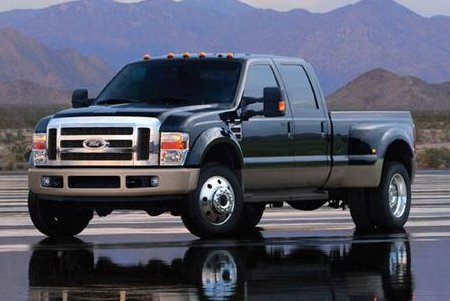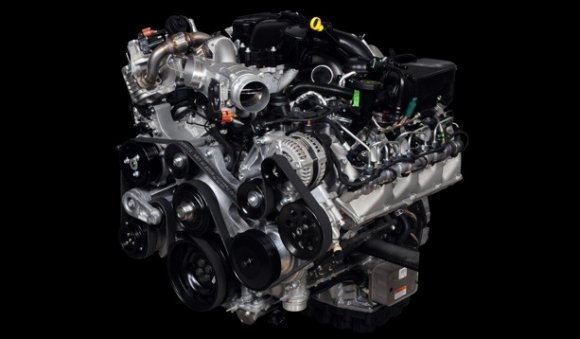
A new era in Ford diesel technology arrives with the Ford-engineered, Ford-tested and Ford-manufactured 6.7L Power Stroke V8 turbocharged diesel engine. Debuting in the next-generation 2011 Ford F-Series Super Duty truck, the new diesel engine will deliver significant improvements in torque, horsepower and fuel economy while adding more fueling flexibility and easily meeting stringent new emissions requirements.
The new diesel 6.7L engine, code-named Scorpion, also shares the Super Duty’s legendary reliability and durability while delivering best-in-class towing and payload.
The diesel engine team made improvements and changes throughout the engine architecture to deliver on aggressive horsepower, torque, emissions and fuel economy targets. The 6.7L Power Stroke uses an “inboard exhaust” architecture, an automotive-industry first for a modern production diesel engine. It combines the best of proven technology with new, patented approaches backed by an extensive laboratory and real-world testing regimen to assure customer satisfaction.

Benefits of the new 6.7Lr Power Stroke V8 turbocharged diesel engine include:
- First use of a compacted graphite iron (CGI) engine block in a Super Duty-class vehicle in North America; stronger than regular gray cast iron, Ford has successfully used CGI in engine blocks in products around the world. The block structure was optimized for reduced weight and maximum strength to meet the demands of higher torque and horsepower
- Unique inboard exhaust and outboard intake architecture, an automotive-industry first for a modern production diesel engine, reduces overall exhaust system volume, which leads to better throttle response for the customer; additionally, reduced exhaust system surface area minimizes heat transfer to the engine compartment and improves NVH (noise, vibration, harshness)
- The new engine architecture enables easier service work for all major engine components, potentially reducing down time. On turbocharger service, for example, the body/cab no longer has to be removed from the frame to access the turbo; also, the high-pressure fuel pump, EGR (exhaust gas recirculation) components and thermostats are directly accessible from the front of the vehicle
- Honeywell’s single-sequential turbocharger features an industry-first double-sided compressor wheel mounted on a single shaft. The unit is uniquely center-mounted on a pedestal low in the back of the valley for improved NVH. This turbocharger design allows the single unit to deliver the benefits of a twin-turbocharger system in a smaller, more efficient package, combining the benefits of a small turbocharger (faster response) and a large turbocharger (ability to compress and force more air into the engine for more power) in one unit
- The high-pressure Bosch fuel system injects fuel at up to 30,000 psi. The system delivers up to five injection events per cylinder per cycle using eight-hole piezo injectors to spray fuel into the piston bowl. The direct-injection system is calibrated and phased for optimum power, fuel efficiency and NVH
- Aluminum cylinder heads for reduced weight; the mid-deck construction with dual water jackets provides increased strength and optimal cooling; also, six head bolts, instead of four as found on other engines, help improve sealing and maintain cylinder integrity even with the higher firing pressures; overall the engine is about 160 pounds lighter
- Compatible up to B20 fuel, allowing greener fueling options of up to 20% biodiesel and 80 percent petroleum diesel
One of the obvious visual differences in the new 6.7L Power Stroke V8 turbocharged diesel engine is the layout of the pipes. The exhaust manifolds, for example, reside in the valley of the engine instead of outboard, while the intake is outboard of the engine. The cylinder heads are essentially flipped around in comparison with previous V-8 engine architectures.
This unique layout – an automotive-industry first for a modern production diesel engine – has several advantages. First, the overall exhaust system volume is reduced, meaning air can be fed to the single turbocharger quicker for faster spool up and reduced lag, resulting in improved throttle response for the customer. The improved packaging also places components that need to be in cooler air away from hot exhaust pipes, resulting in better thermal management and, by extension, better fuel economy.
The single-sequential turbocharger – an industry first – is key to the new diesel engine’s performance. The unit has two compressor wheels driven off one turbine impeller. This approach combines the benefits of a single inertia wheel – faster response without lag – with the thrust of a larger turbocharger, with the ability to force more compressed air into the engine for more power. The engine’s smaller exhaust volume combined with a corresponding smaller intake volume and smaller turbocharger creates a system that is quicker to boost, more responsive and better able to deliver horsepower and torque, especially at the low end, when the customer demands it.
The turbocharger includes an advanced variable nozzle turbine, which enables variable vane pitch angles, driving optimal turbine power to achieve optimal boosting levels for all operating conditions. The single shaft ensures the transition is seamless. The unit – compact in dimensions – is uniquely center-mounted on a patented pedestal low in the back of the valley instead of hung off the block, which helps balance the system and aids NVH characteristics.
Customers of the 6.7L Power Stroke turbocharged diesel engine will notice a quieter, more refined sound. Improvements to the combustion system, structural integrity of the compacted graphite iron block and the single turbocharger mounted to the engine block account for many of the NVH improvements.
The new 6.7L Power Stroke V8 turbocharged diesel engine seems to be the perfect complement to the 2011 Ford Super Duty, delivering both capability and reliability.






























